How to connect a tumble dryer?
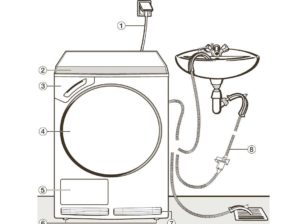 More and more people are choosing a free-standing dryer instead of a washer-dryer. Unlike combined units, using it to dry all washed items can be much more economical and faster. But there are also difficulties - connecting a tumble dryer is somewhat more complicated. So that this difficulty does not become an obstacle to the purchase, it is enough to have detailed instructions before your eyes. It is her that we will give below.
More and more people are choosing a free-standing dryer instead of a washer-dryer. Unlike combined units, using it to dry all washed items can be much more economical and faster. But there are also difficulties - connecting a tumble dryer is somewhat more complicated. So that this difficulty does not become an obstacle to the purchase, it is enough to have detailed instructions before your eyes. It is her that we will give below.
Installation depends on the type of dryer
How the installation process of the new dryer will go depends on the room and type of dryer. First of all, it is important to determine the type of drying, which are exhaust, condensation and with a heat pump. The principle of operation of machines is different, which affects the nuances of their connection.
- Exhausts work by removing moisture with air into the ventilation system, so you need to connect the machine to home ventilation.
- Condensing machines direct heated air into a drum with wet laundry, where it “collects” liquid from the fabric. Next, the flow goes to the provided heat exchanger for "dumping" the vapor, and the "discharged" moisture settles in the provided tank. It needs to be emptied, so for convenience you need to connect to the sewer.
- Units with heat drying are similar to condensing models with the difference that humid air does not pass through the heat exchanger, but the evaporator.
The installation process of the dryer is determined by the type of unit.
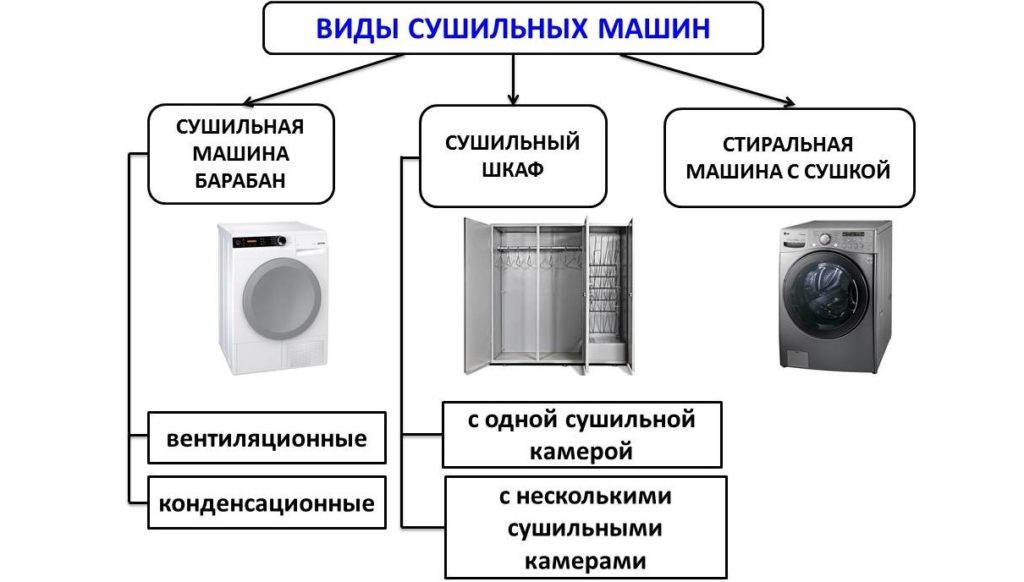
It is most difficult to work with exhaust models, since connection to the duct is required. Not all city apartments and private houses make it possible to freely connect to centralized ventilation. But such machines are being produced less and less - manufacturers are actively replacing them with condensation and "heat pump". We will talk about their installation in the article.
Connection Procedure
Condensation-type dryers and heat pump machines are installed the same way. Moreover, their installation is practically no different from washing machines. The only difference is that you need to be more serious about connecting to the sewer and the mains.
If the dryer is not connected to the sewer, you will have to empty the condensate tray after each cycle.
Connection to the sewerage is optional - you can personally drain the water from the container with the released moisture. But it’s much more convenient and easier to immediately configure the automatic condensate outlet to the drain pipe. It is not difficult to do this: in each model there is a special hole for the hose. Water is discharged into a common drain or into a sink, bath or toilet.
Further we bring electricity. To ensure current supply, it is necessary to withdraw a separate line from the distribution panel or use a ready-made outlet. The second option is faster and more convenient, since often there is a free outlet for connecting to the mains. The method is not inferior to safety - if the power of the dryer does not exceed 2.5 kW, nothing threatens the wiring. The main thing is not to forget that the line should have grounding, an RCD and a separate circuit breaker. It is enough to include in the circuit an RCD for 16 amperes and a machine for 14-16 amperes.
It is strictly forbidden to use the simultaneous connection of a tumble dryer and a washing machine into one double outlet. Remember that this will result in increased power and overloading the outlet. Excessive heating, melting, and short circuiting will occur.
Where to put the dryer?
The issue with the connection is directly related to the placement of the machine in the room. From where it is and how it stands, the nuances of installation depend. Therefore, first we choose one of four options: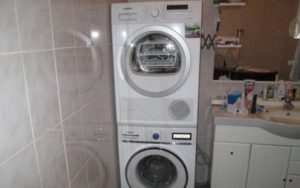
- on top of the washer;
- next to the washer;
- in a special niche or closet;
- under the sink or countertop.
Most often, owners of dryers prefer the so-called “column”, when the dryer is installed directly on the washer. Square meters are greatly saved, which is what residents of small-sized apartments and houses strive for. But you can’t just put one unit on another - you must follow the instructions from the manufacturer.
- Check that the washing depth is greater than or equal to the drying depth. If there are discrepancies, the "lower tier" will not withstand the load.
- Install special anti-tipping locks and caps on the washing machine body. They go in combination with a dryer, if it is possible to install in a column.
- Unscrew the legs from the dryer and fix it in the caps.
- Adjust the position of the machine according to the building level.
It is strictly forbidden to mount the dryer in a column without reliable fixation!
There is another option - to use wall structures in the form of special rails. These latches are more reliable, but are rare, since anti-tipping mounts are several times more aesthetic.
It is impossible to neglect the provided clamps. They not only protect the washing machine from outgoing vibration, but also enhance the stability of the “upper tier”, preventing the appliance from tipping over.
If you do not want to contact the clips, you should put the dryer next to the washer. This method is safer and easier, but requires free space in the room. Suitable when there is a large area or the ability to place the machine in a separate room, closet, dressing room or a spacious corridor. Installation in this case is limited to moving, removing the transport bolts and leveling the building level. It is better to immediately buy household appliances in a pair, so that a single style reigns in the bathroom or in the kitchen and the dimensions coincide completely.
The option of installing drying in a drywall niche requires a special corner or cabinet. It is better to think about this in advance, even during the repair of the premises. If possible, you can build a two-story structure with your own hands - to accommodate both dryers and washing machines.
It’s even easier to identify the machine under the sink or countertop of the kitchen set. It is only necessary to correctly select the model so that it has a removable cover for embedding and the dimensions corresponding to the cabinets. The condensation dryer is especially “comfortable” in the kitchen, as it is easy to connect the dryer to the drain due to free access to the sewage system.
There is no reason to be afraid of installing a tumble dryer - in many ways, the procedure for connecting to communications is identical to washing machines. The main thing is to think about safety and not to neglect the rules specified by the manufacturer.
Interesting:
Reader Comments
- Share your opinion - leave a comment
Headings
Washing machine repair


For buyers
For users

Dishwasher

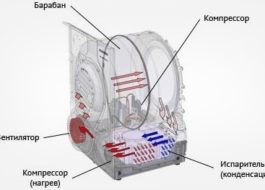
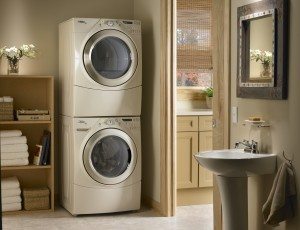
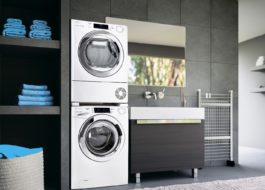
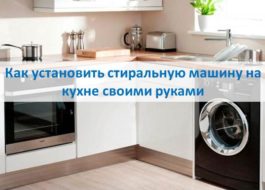
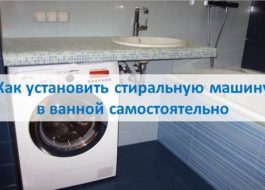
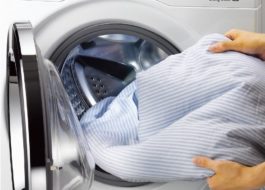











Add a comment